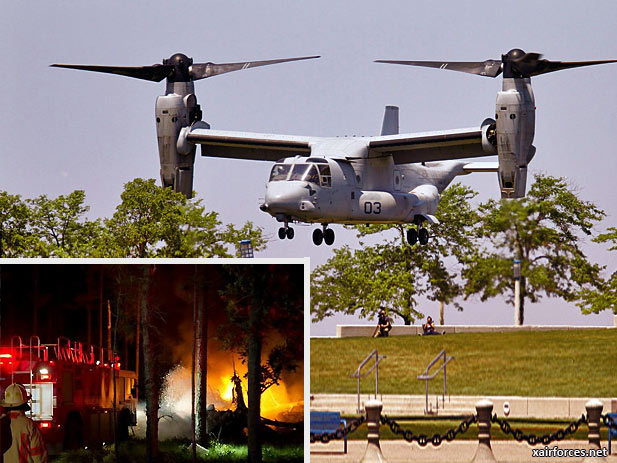
Airmen Injured During CV-22 Osprey Crash Treated At Local Hospitals

Five aircrew members were injured when their tilt-rotor aircraft crashed north of Navarre, Fla. on the Eglin Range.
At approximately 6:45 p.m. June 13, Hurlburt Field was notified that a 1st Special Operations Wing aircraft had crashed on the Eglin Range during a routine training mission. Emergency responders from the base and Okaloosa County arrived at the scene where they found the five members of the aircrew and transported them to local hospitals.
None of the injuries are life-threatening.
Major Brian Luce, one of the pilots, was transported to Eglin Air Force Base hospital, where he is listed in stable condition.
Captain Brett Cassidy, the second pilot, was transported to Sacred Heart Hospital in Pensacola, where he is listed in stable condition.
Staff Sgt. Sean McMahon, flight engineer, was transported to Sacred Heart Hospital in Pensacola, where he is listed in guarded condition.
Tech. Sgt. Christopher Dawson, flight engineer, was transported to Eglin Air Force Base hospital, where he is listed in stable condition.
Tech. Sgt. Edilberto Malave, flight engineer, was transported to Sacred Heart Hospital in Pensacola, where he is listed in stable condition.
"Supporting our families at home is a critical component of defending our nation abroad," said Col. Jim Slife, 1st Special Operations Wing commander. "Right now, our efforts are focused on doing all we can to support our injured Airmen and their families."
A board of officials is investigating the accident. Base officials stress that the accident site may contain hazardous materials released from the crash, and ask that individuals refrain from entering the area.
Source: HURLBURT FIELD, Fla. - US Air Force Special Operations Command; issued June 14, 2012
Photo Story: 5 airmen injured when Osprey crashes in Florida (NAVARRE, Fla. (AP))
All five airmen aboard an Air Force CV-22 Osprey were hospitalized after the tilt-rotor aircraft with a checkered safety record crashed in the Florida Panhandle, but none of the injuries were life-threatening, military officials said Thursday.
The Osprey, which can take off and land like a helicopter but has wings for level flight, went down Wednesday shortly before sunset in a remote area of Eglin Air Force Base's sprawling reservation north of Navarre, said Airman 1st Class Michelle Vickers at nearby Hurlburt Field, where the Air Force Special Operations Command is headquartered.
Col. Jim Slife, commander of Hurlburt's 1st Special Operations Wing, said his unit's efforts are focused on supporting its injured airmen and their families.
"This particular mission was a gunnery training mission, so it was a two aircraft formation out performing gunnery," Slife said at a news conference. "When the lead aircraft turned around in the gun pattern, they did not see their wingman behind them so they started a brief search and found they had crashed right there on the range."
The aircraft was found upside down and caught fire but did not burn entirely, the Northwest Florida Daily News of Fort Walton Beach reported. The aircraft is one of 25 Ospreys in the Air Force Special Operations Command.
"Some of the individuals who were injured were airlifted out, but others were taken out by ambulance," Vickers said.
Maj. Brian Luce, one of the pilots, and Tech. Sgt. Christopher Dawson, a flight engineer, were listed in stable condition at Eglin's hospital.
Capt. Brett Cassidy, the second pilot, and Tech. Sgt. Edilberto Malave, a flight engineer, also were in stable condition at Sacred Heart Hospital in Pensacola. Staff Sgt. Sean McMahon, a flight engineer, was in guarded condition at Sacred Heart.
The Eglin reservation covers 724 square miles, about two-thirds the size of Rhode Island. It is mostly forest but also includes swamps, streams, clearings and remote airfields.
An Air Force board will investigate to determine the cause of the crash, which happened just two months after a Marine Corps version of the aircraft, an MV-22 Osprey, went down during a training exercise in Morocco. Two Marines were killed and two others severely injured in that crash.
Earlier this month, the military put plans on hold for briefly deploying Marine Ospreys to a city in Japan after local officials objected due to the aircraft's safety record.
An Air Force version was the first Osprey to crash in Afghanistan in April 2010, killing three service members and a civilian contractor. Ospreys went into service with the Marines and Air Force in 2006. The Marines began using them in Iraq the following year.
The Osprey initially was developed for the Marines to replace transport helicopters. It can carry 24 troops and fly twice as fast as comparable assault helicopters while retaining the ability to hover. Twin engines with large, 38-foot diameter propellers mounted on the wing tips tilt up for taking off and landing. Each aircraft is priced at about $70 million.
The Air Force version is equipped with a missile defense system, terrain-following radar, a forward-looking infrared sensor and other electronic gear that enable it to avoid detection and defend itself on special operations missions over enemy territory.
The Osprey was nearly canceled several times during its lengthy development due to cost overruns and safety questions.
Nineteen Marines were killed in 2000 when an Osprey crashed during a training exercise in Arizona. Another MV-22 crashed in North Carolina, killing four Marines, in December of that year.
When former Vice President Dick Cheney was defense secretary, he tried to kill the program in 1989, saying the aircraft wasn't needed, but the Marines persuaded Congress to keep it going. (keprtv.com)
Small Photo: Local emergency responders extinguish the fires caused by the CV-22 Osprey crash that occurred at Eglin Range at 6:45 p.m. June 13, 2012. Eglin and Hurlburt Field firefighters reacted quickly to control the flames from spreading and causing further damage to the local environment. (U.S. Air Force photo/Airman First Class Christopher Williams)
(14.06.2012)
|